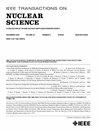Experimental Study on Enhanced AlGaN/GaN HEMT Under Different Irradiation Conditions
IF 1.9
3区 工程技术
Q3 ENGINEERING, ELECTRICAL & ELECTRONIC
引用次数: 0
Abstract
This article mainly studies the total ionizing dose (TID) effect of enhanced AlGaN/gallium nitride (GaN) HEMTs under Co不同辐照条件下增强型 AlGaN/GaN HEMT 的实验研究
本文主要研究了Co ${}^{60}~\gamma $ -射线辐照下增强的AlGaN/ GaN HEMTs的总电离剂量(TID)效应和36Kr重离子辐照下的单事件烧坏(SEB)现象。研究发现,阈值电压的负移是由于p-GaN/AlGaN界面上空穴的积累,与栅极偏置和辐射剂量成正比,而与击穿电压无关。当TID达到一定的影响度时,阈值电压的负移也会达到饱和。SEB损伤可以是永久性的,燃尽阈值随流量变化显著。Sentaurus模拟成功地再现了SEB过程,并解释了漏电流的双峰现象,表明离子注入后电子空穴对(EHPs)的急剧增加导致电子阱捕获的增加,从而产生更高的自生内部电场,导致器件烧毁。
本文章由计算机程序翻译,如有差异,请以英文原文为准。
求助全文
约1分钟内获得全文
求助全文
来源期刊

IEEE Transactions on Nuclear Science
工程技术-工程:电子与电气
CiteScore
3.70
自引率
27.80%
发文量
314
审稿时长
6.2 months
期刊介绍:
The IEEE Transactions on Nuclear Science is a publication of the IEEE Nuclear and Plasma Sciences Society. It is viewed as the primary source of technical information in many of the areas it covers. As judged by JCR impact factor, TNS consistently ranks in the top five journals in the category of Nuclear Science & Technology. It has one of the higher immediacy indices, indicating that the information it publishes is viewed as timely, and has a relatively long citation half-life, indicating that the published information also is viewed as valuable for a number of years.
The IEEE Transactions on Nuclear Science is published bimonthly. Its scope includes all aspects of the theory and application of nuclear science and engineering. It focuses on instrumentation for the detection and measurement of ionizing radiation; particle accelerators and their controls; nuclear medicine and its application; effects of radiation on materials, components, and systems; reactor instrumentation and controls; and measurement of radiation in space.
 求助内容:
求助内容: 应助结果提醒方式:
应助结果提醒方式:


